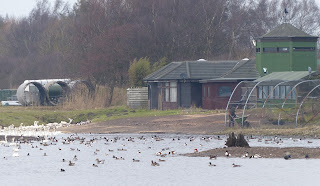Despite being ill and suffering with treatment, Russ still tried to be part of the birding community in the valley, and asked to be kept up-to-date with bird news. One of the last birds he found on a visit to the valley was a single Waxwing in the Bank Island car park. Russ was a true 'local patch' birder, and most interested and happy when finding his own birds, especially in the Lower Derwent Valley which was a special place to him, and a site in which he introduced many of his birding friends to.
Over the years Russ amassed an impressive valley list, but again it was in finding his own birds which gave him the most enjoyment, and finds such as Great White Egret, American Wigeon, Green-winged Teal, Pectoral & Buff-breasted Sandpipers and Snow Buntings head a long list, whilst Gannet and Bearded Tit frustratingly and seemingly constantly eluded him, but which he took with his own great sense of humour. It was however not just rare and scarce birds that held Russ's attention, but also in recording movements and counting commoner species as well, which Russ avidly recorded and for which we are so much better off.
Well liked and highly respected, Russ became the official 'bird news hub' of the LDV, getting along with everyone as he did so well, and passing on the many records that came his way. Living more locally in Wheldrake village in recent years gave Russ the opportunity to quickly 'get on' to local birds and also see the capture of birds during ringing. This gave him the opportunity which not many have had, to see some of the 'Ings specialities' in the hand, including Garganey, Spotted Crake and Quail to name a few.
An NNR volunteer for over 20 years, Russ was always keen to ensure the LDV and its records got the merit, justification and protection they deserved, and so he worked closely with the YOC, YNU and Natural England. He worked particularly hard alongside us in the LDV, with 'difficult to survey species' such as Black-necked Grebes and Spotted Crakes which can appear in the valley in above 'the norm' or expected numbers. Russ was keen to help in any way he could, and took part in the BBS and farmland bird surveys, along with helping us with WeBS counts and various ringing projects. He was always keen to come out and help drag-net Jack Snipe or mist net Whimbrel, or merely spend hours trying to read off colour-rings.
Russ wasn't just simply into birds as a hobby in which he took enjoyment from, he went the extra mile and was passionate about birds and their conservation in the LDV, which saw him roll up his sleeves and get stuck into practical habitat management with us, that in the long term would benefit the site, the birds and the enjoyment of others.
Russ's relationship with the valley goes back over 30 years, and his friendship with Craig for 23 of those, back in the day when they were both 'young lads' they'd spend many an hour discussing birds and through this friendship Russ helped inspire Craig's enthusiasm for the valley and in monitoring/researching the less understood species. Together they analysed records, looked for trends and patterns, and predicted the occurrence of the less frequently encountered species. Russ then took it one step further and went onto writing about them and soon became the accomplished author of the 'Rare Birds Where and When' and the 'Rare and Scarce Birds in Yorkshire', he also wrote various short papers on the status of seabirds in the York area for the local YOC reports. These fascinating reads were also part of the inspiration for the publication of Craig's book on the birds of the LDV.
The Lower Derwent Valley has sadly lost a true supporter and advocate, and the birders, volunteers, and all the LDV Natural England staff and friends have lost a true ornithological gentleman. Finding the next rare bird or local scarcity or catching the next unusual bird whilst ringing will now be tinged with sadness, but we shall go on and keep Russ's memory with us. It was a true pleasure to know Russ, and our thoughts are now with Linda, and his two young daughters.





























.JPG)
.JPG)




.JPG)
























